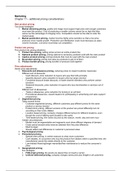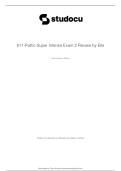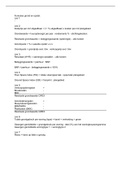Lecture 1 - introduction into heart function
WPW (wolff-parkinson white) is an example of a heart disease with an extra connection in
the AV node, it can lead to ventricular fibrillation.
The function of the heart
The heart should pump deoxygenated blood into the lungs and oxygenated blood into all
other organs in the body. Both the left and right ventricle should contract and relax at the
same time (this contains the cardiac output, how much blood is pumped out of the heart).
Excitation-contraction coupling
Excitation-contraction (EC) coupling is a crucial process that connects electrical signals
(action potentials) from the nervous system to the muscle contractions. In the cardio-
myocites this relies on calcium ions (Ca2+) entering the cells, and more calcium coming
from the sarcoplasmic reticulum forming the calcium-induced-calcium release.
The heart beats automatically
The heart beats independent of hormonal or neural input, it is spontaneous active
throughout pacemaker-cells.
Conduction of the heart
From top to bottom: SA-node (pacemaker-cells), AV-node, AV-bundle,
Bundle branches and Purkinje fibers. The AV-node is the slowest
(because the atria and ventricles do not contract at the same time), the
rest of the cells are very quick.
Pacemaker cells
The action potential provides a specific rhythm. At the beginning the
pacemaker-cells in the SA-node are negative (-60v). To make the cell less negative Na+
(sodium, natrium) and Ca2+ (calcium) are entering the cells. When the threshold is reached,
K+ (potassium, kalium) is leaving the cel to lower the membrane potential again. In voltage-
gated channels the process is a bit different.
- Heart rate determined by: resting membrane of SA-node cells and velocity (snelheid)
of depolarisation.
The action potential
The action-potential can be subdivided in 3 stages. The first is the
absolute refractory period (1). The second the relative refractory
period (2) and the third the supranormal period (3).
,Maintenance of the blood-supply
- Sympathetic system: fight-or-flight
- Parasympathetic system: rest and digest
- Normal heart-rate = 100 bpm
Increased and decreased heart rate
- Sympathetic: adrenaline and norepinephrine → the sodium (Na) channels
open a little more, the threshold will reach earlier.
- Parasympathetic: acetylcholine → the potassium (K) channels open a little
more
Heart rate in a donated heart
The heart rate of someone with a donor heart is a bit higher than normal. In the
operation the sympathetic and parasympathetic nerves will be cut off. Because
normally you are parasympathetic dominant, and you do not have this system
anymore → higher heart rate.
Excitation-contraction coupling
Calcium determines everything in the heart (is king). The SR is a storage of calcium (Ca2+).
When the potential changes because of calcium in the cell, the SR releases even more
calcium which leads to a contraction of the heart. To relax the heart again SERCA together
with a lot of energy binds the calcium back into the SR.
- To make the heart muscle contract, calcium causes the cell ends to come together.
The cardiac cycle
The cardiac cycle consists of two phases, the systolic phase (contraction of the heart) and
the diastolic phase (filling of the heart). The blood flow through the heart is completely
determined by pressure differences. The different phases are:
Passive filling
- AV valves: open
- Aorta/pulmonary valve: closed
The blood will stream from the atria into the ventricles, pressure <5.
Atrial kick
- AV valves: open
- Aorta/pulmonary valve: closed
The atria will contract, all the blood is going into the ventricles.
Isovolumetric contraction
- AV valves: closed
- Aorta/pulmonary valve: closed
Pressure will become higher in the ventricles.
Ejection
- Av valves: closed
- Aorta/pulmonary valve: open
,Pressure in ventricles >70, blood will go to the organs
Isovolumetric relaxation
- AV valves: closed
- Aorta/pulmonary valve: closed
Pressure in the ventricles becomes too low to pump blood to the
organs. Calcium will be taken up back into the SR, and the heart's
relaxation begins. After this the passive filling starts again.
Volume
Diastolic: isovolumetric relaxation, passive filling and atrial kick
Systolic: isovolumetric contraction and ejection
- End diastolic volume: maximal amount in the ventricle (after filling)
- End systolic volume: minimal amount in the ventricle (after ejection)
Stroke volume (slag volume)
End diastolic volume (EDV) - End systolic volume (ESV) = Stroke volume (SV)
- EDV (120) - ESV (40) = 80 ml/stroke (how much blood you eject)
(EDV - ESV) / EDV = Ejection fraction
- (120 - 40) / 120 = 0,67 = 67%
- When ejection fraction is lower than 45% → heart failure (systolic
dysfunction)
Heart sounds
The AV valves have different names for each side. The right AV-valve is called the Tricuspid
valve (right), the left AV-valve is called the Mitral valve (left).
- 1st heart sound = systole (closing of the mitral and tricuspid valve), low pressure/low
frequency
- 2nd heart sound = diastole (closing of the aorta and pulmonary valve), high
pressure/high frequency
Cardiac output
Stroke volume (SV in ml) x Heart rate (HR per min) = Cardiac output (CO ml/min).
This is correlated with the VO2-max, the maximum amount of blood you can pump out of
your heart. An athlete more often has a lower heart rate and a higher SV. Normally it is
around 5-6 liters (per minute), in exercise it can reach up to 15 liters (per minute).
Frank-starling mechanism (preload)
The frank-starling mechanism explains that an increase in the filling pressure of the heart
(more blood in the ventricles) leads to an increased stroke volume (the amount of blood
pumped out with each heartbeat). This mechanism is important for ensuring that the amount
of blood entering the left and right sides of the heart matches the amount being pumped out.
It's particularly crucial at the beginning of activities like exercise when your heart rate may
not yet be very high, but your body requires more oxygen. The return of blood from the veins
in the legs plays a significant role in increasing the filling pressure, which increases stroke
volume. When the right ventricle pumps more blood, the left ventricle naturally follows.
Adrenergic stimulation (noradrenaline)
, Adrenergic stimulation refers to the activation of the sympathetic nervous system, which
releases adrenaline and noradrenaline (epinephrine and norepinephrine) to increase heart
rate and contractility. While it is a critical physiological process, it may not be necessary to
memorize the details.
Afterload
Afterload is the force that the heart must overcome to open the aortic and pulmonary valves
and eject blood into the systemic and pulmonary circulation. When blood pressure
increases, the afterload also increases. Decreasing afterload leads to a reduction in blood
pressure. Afterload increases when peripheral blood vessels constrict (vasoconstriction) and
decreases when they dilate (vasodilation).
Long-term high blood demand
Long term demand of blood (because of exercise, high blood pressure/hypertension or
pregnancy for example) will lead to hypertrophy (growth) of the ventricles. So, the ventricles
can pump out blood more efficiently.
Lecture 2 - Bench to bedside research in hypertrophic cardiomyopathy: engine,
energy and fusion
Hypertrophic cardiomyopathy (HCM) is an autosomal dominant genetic condition where the
heart muscle thickens abnormally, often due to specific genetic mutations. It can lead to
irregular heart wall thickening, myocyte disarray, and the formation of fibrous tissue. HCM
increases the risk of life-threatening heart rhythm issues, including sudden cardiac death.
Early genetic diagnosis and monitoring are crucial for managing this condition.
Hypertrophic cardiomyopathy
Hypertrophy can occur in the septum of the heart. When this happens mostly someone gets
diastolic dysfunction, and if the septum gets thicker, systolic dysfunction can occur as well. If
it is very severe there is no blood flow at all because the mitral valve gets sucked in (image).
The disease
In the DNA there is a disease causing mutation, that leads to:
- Histopathology: myocyte hypertrophy and disarray, fibrosis and small vessel disease
- Physiopathology: LVH, diastolic dysfunction, LVOT obstruction, arrhythmias
- Symptoms: dyspnea, chest pain, syncope, palpitations and SCD
Disease of the sarcomere
This disease has a prevalence of 1/500. There are 1500 types of mutations that can lead to
HCM. The disease plays a main role in the sarcomere (muscle fiber). The problem with HCM










